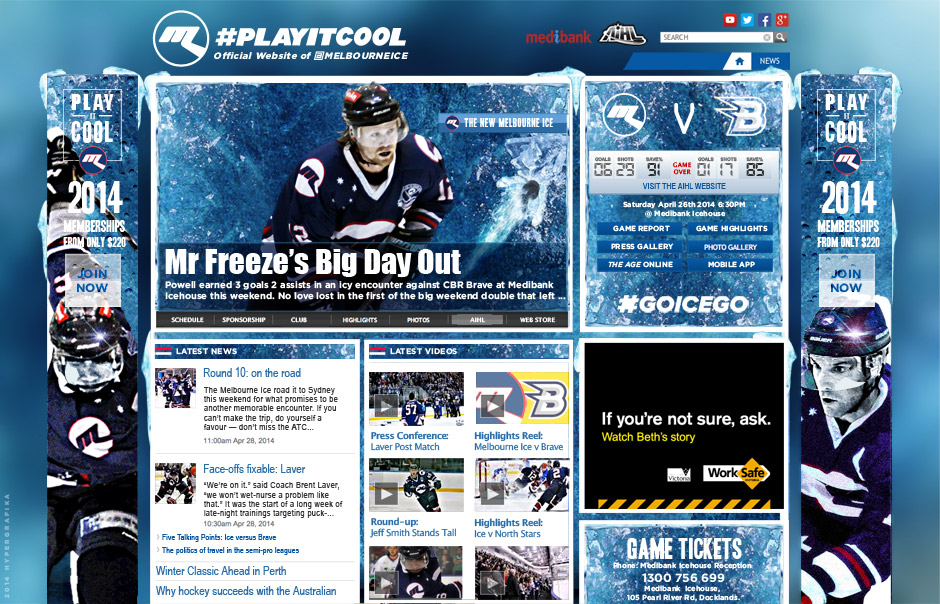Legends
home
From a desert, from the driest continent, from this land at the opposite end of the globe ...
... as remote as could be in the hockey world ...
... came one of the world’s oldest winter sports trophies.
A cool tradition, a dream of champions, and a story we owe it to our children to tell.
Legends of Australian Ice.


Website concept design. Full Size In separate window.
UPMANSHIP
The art of successively outdoing a competitor without actually cheating | May 2014
Stephen Potter said if you are not one-up, you are one-down, which probably explains why there are legions of opportunistic scoundrels out there peddling unprincipled help for deriving maximum undeserved rewards and discomforting the opposition.
Then there are the very wise ad guys who prophesied the best way to enhance the fan experience is to ice a competitive team. A prophet is not without honour, or save in his own country. Yes, fans do want to see wins but those of us who have actually wrangled with that marketing concept know it is a bit of a vicious circle... filling seats helps fund the club, which helps attract better players and coaches, which helps teams win. Winning games definitely factors, but it's not everything.
Caught in the cross-fire are actual fans. Some want better rink amenities while still others want the glamour of their team on high-def, big-screens in their own home, avoiding things like the crucifixion of good metal music played through tinny speakers in a perfect reverb chamber; narcissistic talk over the top of play (with an accent, of course); out-of-control ticket and parking prices...
Why don't organizers get it? Many fans have unspoken needs they cannot articulate. They seek experiences with their local hockey community that they can't get at home. Not gimmicks. Excitement. Thrills they haven't even thought of yet. The rush of getting noticed. Learning chants and arm waves by heart. Surrounded by like-minded others who would likewise lay down their life for the club colours. Feeling part of something bigger than yourself for one glorious moment.
Clubs have to know their fans and anticipate what they need. And what they need most is to feel that an experience is imminent. It's the 21st century. The dawn of smart phone apps for watching video replays, updated stats and live video from other games. Only for those who buy or subscribe to the app. And only while watching the game at the rink. Every sport has something like the NHL Game Centre. Every club could market their own just like the Senators. Fans would pay 99 cents for that to cover development costs. That's what fandom means in the second millenium. And it has only just begun.
Fans can now belong to an exclusive game day community. Companies such as ATC Productions that presently donate services could mine these revenue generating opportunities to prosper. And while it all peaks when the siren blows, it need not, should not stop there.
More value, more offerings could spill over the boards and into the stands, out of the rink and into the club's website and social media. Replays, better angles, fresh designs, tags, offerings, timely stats, match insights. Then: who's next? Vids and stats of last encounters, are they full-strength? who's missing? who's playing for us? what will it mean if we w-i-i-i-n? If we lose? If they win or lose?
To say AIHL club internet offerings have improved is an understatement of Herculean proportions, but not universally. AIHL club websites desperately need to be more fresh and alive. Overlooked, it seems, now second fiddle to the club Facebook pages maintained by volunteers. Custom websites cannot be done that way yet they must also change and improve. They should extend the game day experience in a well-designed way that enables fans to quickly keep tabs on all that should be happening with pre- and post-game content.
That requires effort and good design yet the workload can be reduced in clever ways. By syndication. By sharing the same AIHL boilerplate, perhaps even a highly customized skin of parts of the AIHL site template. Such as the live stats. NHL teams, for example, already do exactly that with their websites. So do the AFL and many other sporting clubs. They're one-up on their competitors. It's an art.
Club websites are a window to the world. They showcase the sport, creating a good or bad impression of how well it is administered, financially managed, and controlled. These things directly effect the return on investment. They are monitored by prospective investors through both public and private portals. They are key indicators of market perception and investor confidence. No public company can really hide poor administration, poor financial management, or internal breakdowns from those in the know. It eventually discloses itself via its own public image and professional sporting organisations are not exempt.
Sports like hockey can attract investment capital for funding such things as rinks and expansion. But their market image must be consistent with the information savvy investors glean from the market, especially from those who work in it and from the market audience. Achieving that is both an art and a science.

